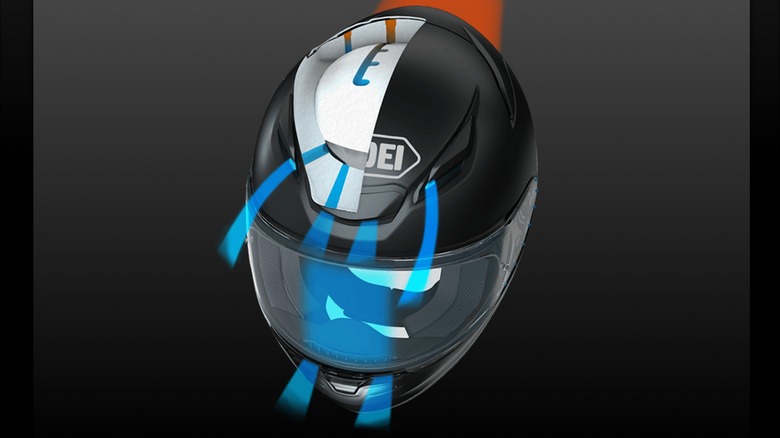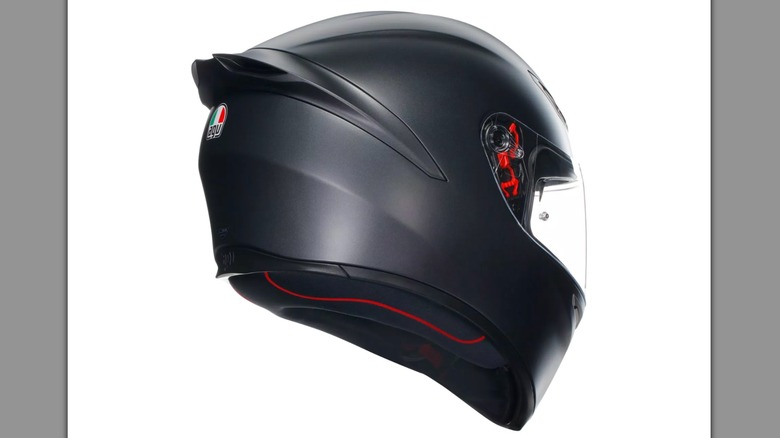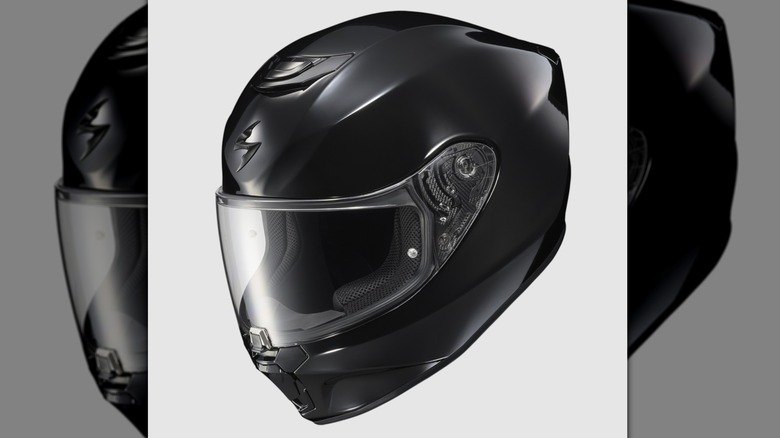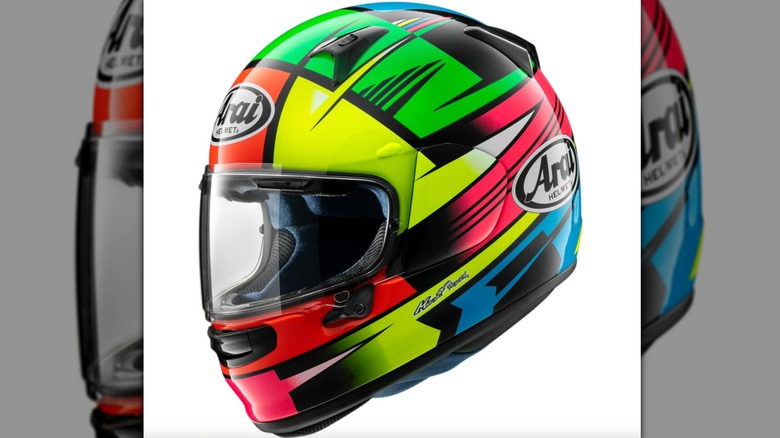5 Of The Best Motorcycle Helmets For New Riders (According To Bikers)
Riding a motorcycle is inherently more dangerous than driving a car. Your body is exposed to the elements and vulnerable to potential impact from objects or collisions with other vehicles. You've got no exterior protection from collisions or abrasions other than what you decide to wear. That's why the gear you pick (and wearing it on every ride) is so important.
Likely the most important piece of essential motorcycle gear you'll pick at any stage in your riding journey is your helmet. Picking a helmet is a tough task, and there are a lot of considerations when you're purchasing protection for your head. You want to make sure you get one that looks cool, that fits well, and that is comfortable to wear with minimal road noise. However, above all other considerations, safety should be the primary concern. So for this list, we're recommending five full-face helmets that meet either SNELL or ECE safety standards, which are tougher than the baseline DOT regulation required for helmets to be road legal.
To clarify: these are all full-face helmets for street riding. Dirt riding helmets, modular helmets, and open-face helmets are all worthy of discussion, but they're best kept to their own separate lists. Can you get safety, comfort, and convenience features without spending your entire gear budget, though? Absolutely. As it turns out, there are a lot of amazing helmets for reasonable money that should suit most beginners.
Arai Regent-X
My current daily-riding helmet is an Arai Corsair-X, and it's one of the best helmets I've ever owned in terms of comfort and usability. Flipping the visor up can be a bit difficult with gloves on, but opening and closing the various air vents is an easy task, and wind noise is relatively low. For most short rides, even on my loud, modified motorcycles, I don't bother putting in earplugs while wearing my Corsair-X. Why mention the pricey Corsair-X and recommend the Regent-X? Well, it turns out that they're closely related helmets.
The Regent-X is a similarly impressive helmet, offering a lot of the same features as the Corsair, but with a lower price point. According to Arai, the two helmets are built with the same protection levels. The Regent-X offers fewer ventilation ports than the Corsair, but if you don't live in a hot climate, that shouldn't be a big issue. A basic Corsair-X will cost you around $930 before taxes, but for significantly less, you can have the very similar Regent-X, which could make it more appealing to new riders. Going with a plain-color version of the Regent-X, for example, will save you a bit of money, with black versions currently being advertised at around $630 before taxes. Go with one of the many fancy graphics, and the Regent-X will cost you closer to $800. Arai says that all their helmets, Regent-X included, meet or exceed the SNELL M2020 standard.
Shoei RF-1400
A Shoei helmet saved my life. Nearly 20 years ago, I had a motorcycle wreck at freeway speeds that put me in a wheelchair for three months. The same way I ride using the ATGATT philosophy today, I was fully geared up then, and my helmet kept me safe from what was likely certain death. The helmet I was wearing, a Shoei RF1100, provided full face protection for me during the crash, and I kept it for years as a reminder to never wear anything less than a full face helmet. Abrasions and deep scrapes lined the helmet in no less than seven different directions. So, naturally, I've got a soft spot for Shoei helmets and the RF lineup.
In the years since my wreck, Shoei has updated its RF helmet several times, and they're currently on the RF-1400. Now, my anecdote doesn't equal a direct correlation with current safety ratings, but thankfully, Shoei has that covered. The RF-1400 is certified by the Snell Foundation with their latest M2025D safety rating. Shoei claims that the 1400 has a reduction in both lift and drag compared to the previous model (the RF-1200), and the helmet comes with removable and washable interior padding, so that's the comfort consideration covered. Depending on the color you choose, the RF can be a bit pricey, with basic models ranging between $700 and $800 to start. The RF-SR will save you a bit of money (it's around $450), but it has fewer features.
AGV K1 S
I spent several years wearing almost exclusively AGV helmets. They fit my head well, they come in at an affordable price point (so you can change up your style every year or two without spending too much), and I love the MotoGP-style design. One of the biggest benefits of the K1 S is its wide field of view. Some helmets that I've tested from Shoei and Arai have a large chin section below the visor and narrow side view profiles. Turning my head to look in the blind spot that is created, or dropping my gaze to look at a motorcycle's rider, can be distracting. So, with a wild field of vision provided by the AGV helmet, I feel a bit more focused.
The K1 S uses a removable and washable liner, which is an excellent alternative to throwing away your old helmet just because it gets a bit damp or pungent on the inside. The K1 S also meets the latest ECE22.06 safety standard. Prices for the K1 S are extremely reasonable, starting at below $250. If you're looking for a bit more versatility from your AGV helmet, via additional shell sizes and a bit lighter overall weight, there's also the AGV K6 S, but it'll cost you a little more than double what the K1 S is currently listed for. A smaller step up would be to the K3, which offers mid-level features and a lot of fancy color options, ranging between $300 and $350.
Scorpion EXO-330
While I wouldn't generally say bargain shopping is the best bet for safety, this is my budget pick for new riders. The Scorpion EXO lineup has offered lots of strong choices amongst full-face helmets for years, and there are some full decked-out versions currently available with carbon fiber construction and all sorts of features. But if you want an affordable and safe version, the EXO-R330 comes with the latest ECE22.06 rating and a price tag below $150 (even with some of the fancy graphic designs). For that, you don't get much in the way of added creature comforts, but for new riders, this helmet should satisfy them, considering the extremely low price.
I've not personally tested the EXO-330, but reviews from owners are positive, with highlights including helmet fit and comfort. There are some drawbacks to a helmet that's so inexpensive, with some owners complaining about noise and limited ventilation, but if you live in a cool climate, it shouldn't be much of an issue. If you want to upgrade to a helmet with a few more features, you might also consider the Scorpion EXO-T520. It's slightly more expensive, but the EXO-T520 includes a built-in drop-down sun visor and a bit more ventilation. The visor adds a bit of weight to the helmet, but it reduces the likelihood that you'll need to buy a second visor for those sunny bits of your commute. The T520 comes in between $220 and $230 for most solid color choices.
Bell Bullitt GT
If you want maximum style with your helmet to go along with something like a cafe bike, there are few choices as strong as the Bell Bullitt GT. Bell is a well-known name in the motorcycle gear market, offering all sorts of different helmets in different styles, and one of their most appealing to aesthetically-minded riders is the Bullitt line. Simple with retro design and excellent color choices, the Bullitt GT also offers modern safety via its ECE22.06 rating. The Bullitt has a massive field of view, which is a plus for claustrophobic riders. The limited lower chin protection, however, increases wind noise according to owners.
While I don't personally love the look of the Bullitt GT (my helmet choices tend to lean towards sporty, even on retro bikes), I've tried a few different Bullitt helmets on before, and I can certainly attest to their initial comfort and visibility. Depending on which color you go with, the Bullitt GT will cost around $500, but the look and feel are worth it. Every piece of the construction feels premium, and the helmet will look right at home hanging from the handlebars of your retro-styled cafe bike.
How we picked the best helmets
Most of these helmets have been chosen based on extensive personal experience combined with certifications from the available safety organizations that test helmets. Riding with and owning helmets over the long term is a great way to see how they perform in the real world, but safety should always be the top concern. All the helmets here were also selected with reviews from owners in mind. Not every helmet will fit every head shape, and you may just hate the style of a helmet once it's in your hands, so try a few on at your local gear shop if you've got the opportunity, instead of buying them online without a test-fit. And while they're tempting to put on a pedestal, top-tier racing helmets that are extremely expensive were left off this list. Beginners might have a hard time scraping together a four-digit budget for a helmet, so we left those for another time.






